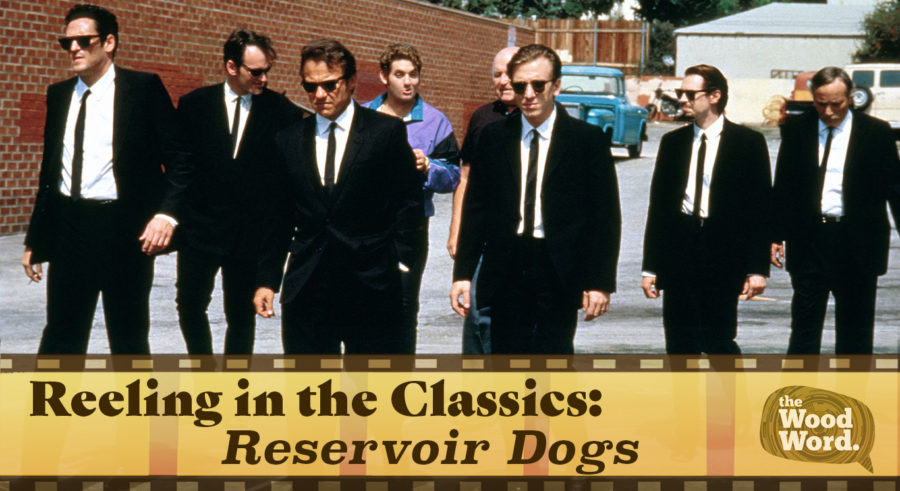Reeling in the Classics: Reservoir Dogs
Photo credit/ Jennifer Flynn
The film “Reservoir Dogs” turned 30 years old this year and kicked off the career of a director and screenwriter who is still quite active today, Quentin Tarantino.
The film concerns the prelude and aftermath of a jewelry heist gone wrong; the actual heist is never seen. We skip around through time as a group of strangers get to know each other and start to get killed off one by one. Eventually, the characters, who are only ever referred to as nicknames, come to the conclusion that there must be an undercover cop amongst them and the killing only accelerates as they lose their tempers and try to figure out who it is.
The blood flows freely, and in the movie’s most famous scene, a cop gets his ear cut off by Mr. Blonde (Michael Madsen), who is otherwise busy grooving to a song playing on a nearby radio. The dialogue is also sharp, witty, and vulgar, with the entire movie opening with Mr. Brown (Tarantino himself) telling everyone his rather sexual interpretation of the Madonna song “Like a Virgin” as the criminals have coffee at a diner. It’s definitely a Tarantino movie, with all of the violence, language, music, and stylistic choices that he would go on to be known for.
But back then, it was a completely different kind of movie, fitting in with the gang violence and foul language of something like “Goodfellas” and mixing that with the swift and succinct scriptwriting of playwrights like David Mamet. So how did people react to it?
After its premiere at the Sundance Film Festival, where, infamously, horror director Wes Craven walked out of its first showing, Miramax picked it up for a wide release and the film subsequently made 2.8 million dollars against its 1.2 million dollar budget. Many critics praised it for how simple it was, as well as the stellar acting and its clever writing, but others like Roger Ebert of Siskel and Ebert thought it was underwhelming and wanted more.
However, a few years later, Tarantino’s follow-up, “Pulp Fiction”, was released, and, naturally, “Reservoir Dogs” got more attention. As of this writing, the movie has an 89% on Rotten Tomatoes, a critic compiling website, as well as an 8.4 out of 10 from the users of internet movie database IMDB. This indicates that it is a generally well-received movie and an impressive first outing for any newcomer to the film industry. It’s also often seen as one of Tarantino’s best films, along with “Pulp Fiction”, and is both a cult classic and a cornerstone of independent filmmaking for many.
Could it be made today, however? Take this from a fan of Tarantino: absolutely not, at least not without some changes.
Just the ear cutting scene mentioned above; even though it doesn’t actually show the ear being cut, it would already be grounds for censorship. But there is so much more as to why it could never be released today in its current form. The film has a total of 99 uses of the “f” word alone, along with many other uses of vulgar language.
In addition, Mr. Orange (Tim Roth) spends much of the movie convulsing and slowly dying from a gunshot wound that leaves his entire suit covered in blood. Mr. Brown also spends a decent amount of time dying from a headshot and the fluid leaking from his head is portrayed quite realistically. And of course, there is copious amounts of gun violence, with people being “shot” on camera (the two that were previously mentioned were wounded off screen). Especially in the wake of the fatal “Rush” shooting, all of this gun violence would need to be vastly toned down.
Violence, death, and blood are definitely still part of any PG-13/R-rated movie experience, but not at this level. And this isn’t an anomaly, either; all of Tarantino’s movies, even his newer ones, share the same amount of violence and blood. But whereas most recent movies only show one or two of the three-such as this year’s “Dr. Strange In the Multiverse of Madness”, which despite all of the violence and death managed only a PG-13 due to little to no blood and gore-Tarantino gleefully shows all three. In fact, he’s gone on record saying he has no plans to change the bloodshed in his movies and infamously has gotten irritated at interviewers who try to pry at this.
So it’s no surprise this movie is rated R and in this current year only a handful of movies are R rated; a good portion are either based on existing properties or straight-up horror movies, of which this film is neither. So this could never be made today, at least not without it going straight to a streaming service like Netflix or changes to the violence and blood levels being made.
Even though it didn’t cost a lot of money to make, it’s hard to argue that it’s not well-made, well-acted, and has an intriguing story. The soundtrack is phenomenal, as would become a standard for Tarantino movies, from well-known classics like “Stuck in the Middle with You” to deeper cuts like “Little Green Bag”.
The writing, if you don’t mind vulgarity, is also top-notch. The style and tone of it ended up being borrowed by other blossoming screenwriters for the rest of the decade and most of the next. The script certainly grabs attention, and beyond that no line is wasted.
Rewatch the “no tips” scene at the beginning of the movie and you’ll find it actually foreshadows a lot of what’s to come, despite the entire thing seemingly like a nonsensical diversion at first.
In conclusion, while this movie was controversial upon arrival and could never be made today without at least a few changes, it is certainly an influential movie in 90s cinema. For those looking to make independent films, or at least try their hands at it, it’s a great example of what can be made with only a million dollar budget, especially for 30 years ago. Even if heists and violence aren’t your thing, it’s worth at least a peek for its style, soundtrack, and the phenomenal cast. Just be mindful of your own triggers and boundaries.
Contact the Writer:
[email protected]

Brianna Kohut is a senior Multimedia Communications major with a minor in Writing. She is also a DJ for VMFM 91.7. When not writing or serving popcorn...









